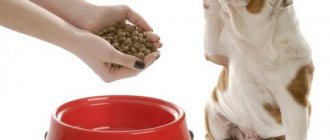Causes
Many factors can cause stomach contractions to slow or stop (impaired motility). Problems with the stomach and its ability to contract are rarely the true cause of stasis, but they also cannot be ruled out. Young animals rarely encounter such problems
Signs and symptoms of stasis are usually manifestations of other diseases that stop the stomach from working. These include:
Reaction to drug use
Stress, pain or injury
Stomach or intestinal infections (gastritis, enteritis)
Blockage or obstruction of the stomach or intestines
Surgery to the intestines or stomach
Metabolic disorders (anemia, hypothyroidism, acidosis)
Bloating and cramping in the stomach (gastrectasia - volvulus or intestinal obstruction)
Enlarged esophagus (megaesophagus)
Symptoms
Dyspepsia can be caused by a cause that does not cause significant harm to the dog's body. But some diseases that are dangerous to a pet’s health sometimes have no signs other than diarrhea, so it is difficult to recognize that a pet is infected with a serious illness.
Each disease that causes indigestion is characterized by certain symptoms, but there are also general symptoms of indigestion:
- increased salivation;
- severe and frequent vomiting;
- increased body temperature;
- lethargy, weakness, refusal to eat;
- constant lying of the animal on its side;
- diarrhea (may contain impurities of mucus, blood, food debris).
As a rule, the appearance and consistency of excrement can be used to judge whether a dog has a disease. Diarrhea mixed with blood indicates the development of an infectious disease, damage to the walls of the stomach and intestines, and poisoning with potent poisons.
White feces indicate liver pathologies, green feces are a sign of distemper, yellow or gray watery stools are a clear symptom of parvovirus enteritis.
Black diarrhea should prompt a dog owner to seek veterinary attention immediately, as black stools can be a sign of internal bleeding.
Often, due to improper feeding, stomach ulcers develop in dogs. Frequent changes of food, low-quality food, alternating hot and cold dishes given to the dog, stress, taking medications, diseases of the internal organs - all this can provoke the formation of erosions on the walls of the stomach. Symptoms of ulcers are:
- Vomit . The masses ejected by the stomach are usually dark in color and sometimes contain blood. Vomiting attacks occur very often and do not bring any relief to the pet.
- Diarrhea. Diarrhea begins to accompany the dog constantly, while the feces are liquid, black, and look like tar.
- Lethargy, apathy. The animal increasingly prefers to lie down and refuses to play.
- Loss of interest in food, increased volume of urine, fever, extreme thirst, heavy breathing.
Diagnostics
The veterinarian will perform the necessary tests to rule out a potential cause of vomiting. These include a physical examination, complete blood count, chemical profile, urine, stool, and x-ray. If necessary, a special technique called contrasting is used. In this study, a liquid substance (barium suspension) is given orally , which appears on an x-ray. The photographs track the progress of the substance throughout the body.
If necessary, doctors can resort to special studies. , a flexible tube (endoscope) is used to examine the stomach and intestines . In this case, the animal is given anesthesia. With this device, small tissue samples (biopsy) can be collected for testing. After their analysis, serious stomach diseases such as cancer can be ruled out.
Treatment
Most animals can be helped at home with dietary changes . A low-fat, low-fiber diet with a semi-liquid or liquid consistency is usually recommended. The animal should eat often, but in small quantities. Often, when gastric motor function is impaired, changes in diet help solve the problem. In cases of severe vomiting and diarrhea, dogs are hospitalized and treated with IV fluids containing liquid medications and electrolytes. Depending on the cause of the disease, surgical treatment may be used
Drug treatment helps strengthen muscle contractions and remove blockages from the stomach of animals that have been suffering from the disease for a long time. The two main drugs used to treat stasis are metoclopramide and cisapride. Metoclopramide is administered orally 30-45 minutes before meals and has antiemetic properties. The use of the drug has reversible side effects such as behavioral changes, depression or hyperactivity.
Cisapride is also administered orally 30 minutes before meals. It stimulates motor function and has been shown to be more effective than metoclopramide. Cisapride has no side effects on the nervous system, but can cause vomiting, diarrhea and depression. The sale of this drug is limited due to side effects in humans, but veterinarians can purchase it through special pharmacies.
Other drugs that help cleanse the stomach and improve gastric motor function in dogs include: erythromycin, clarithromycin, domperidone, rantidine and nizatidine.
How to treat constipation in a bedridden patient
If a person cannot empty his bowels on his own, many relatives have a problem - how to help a bedridden patient empty his bowels? This can create some problems, because if a person has constipation, then some food must be excluded. If you do not consult a doctor and independently try to cleanse the intestines of a bedridden patient using enemas, after some time the patient will again have the same problem as before, because you need to find the cause of constipation (constipation).
Reducing water consumption, foods that cause bloating, and simply not following the diet prescribed by your doctor can cause serious health problems. Treatment of constipation always goes “in one direction” - it is necessary to achieve liquefaction of stool and its removal. To do this, doctors come from different directions at once: they find out what exactly caused the constipation and prescribe drug therapy.
Important!! Emptying the bowels of a bedridden patient can be achieved with medications or an enema. Such a seemingly insignificant procedure as an enema should only be prescribed by the attending physician, since some patients have absolute contraindications (thin intestinal walls, surgery and the presence of sutures, anastomoses on the intestines). If you prescribe an enema yourself, you can seriously harm the patient.
Medicines are divided into several groups, different in their effect on the gastrointestinal tract, as well as on the general condition of a person:
Some drugs can also be prescribed to patients who do not have problems with stool retention. For example, with cirrhosis of the liver or liver failure, it is important for patients that feces remove waste products from the body, so it is necessary that the person has frequent bowel movements.
Prescribing such medications without a doctor is unacceptable. For example, if you do not calculate the amount of medicine, you can cause intestinal spasms and severe diarrhea, and you should also take into account that such drugs (like any other medicines) have side effects and contraindications for use.
Gastritis in dogs: symptoms, treatment, nutrition
Gastritis is one of the most common gastrointestinal diseases in dogs. It can occur for a variety of reasons, but in any case it causes serious discomfort to the pet and leads to a change in the chemical composition of gastric juice. Without treatment, gastritis can lead to serious complications, one of which is peptic ulcer of the stomach and duodenum.
To learn how to identify gastritis in a dog, why it occurs, and what effective treatment should be, see below.
Read in this article:
What bowel problems can occur in a bedridden patient?
Most often, a bedridden patient develops only 2 problems with intestinal upset and have completely opposite effects - diarrhea and constipation. If there has been a change in the usual diet, poor quality food or unwashed vegetables or fruits, then the patient develops severe diarrhea.
Constipation – (the correct medical name is “constipation”) occurs when a person has eaten foods that cause increased gas formation or have a lot of dietary fiber, creating a fecal plug in the patient’s intestines. If a bedridden patient does not have stool for more than two days, it means that he has developed constipation and the person needs help to empty his bowels. When solid feces stop moving, they accumulate and after a few days, physiological bowel movements will become impossible and you will need to contact a specialist.
In bedridden patients, constipation causes disruption of the kidneys, which leads to severe intoxication of the body, since the elimination of unnecessary substances is disrupted and they accumulate in the body.
In older people, in whom normal peristalsis weakens with age, the number of villi lining the inner surface of the intestines also becomes smaller. Therefore, older people often develop intestinal obstruction, and if an elderly person is bedridden, there is a chance of constipation, and, as a consequence, fecal obstruction. Such patients most often end up on the operating table, since only in this way is it possible to remove feces and establish adequate stool in a person.
Common Causes
In 8 out of 10 cases, the cause of gastritis in a dog is poor quality nutrition. By giving your pet economy-class dry and liquid food, low-quality meat and low-quality vegetables, you risk his health, since they will inevitably lead to problems with the gastrointestinal tract.
Another common cause of gastritis is the wrong choice of food. When creating a diet for your pet, do not forget to take into account its individual characteristics (for example, level of activity during the day and the presence of chronic diseases).
The development of gastritis can be caused by mixing natural and industrial diets, overeating a pet, and even different meal times. Many diseases of the gastrointestinal tract or long-term use of antibiotics can lead to complications, one of which is inflammation of the stomach.
Other causes of gastritis in dogs:
- Violation of the temperature regime of food . The food you give your pet should be at room temperature. You should not give your animal food that you have just taken out of the refrigerator/freezer or that has been overheated.
- Allergy or individual intolerance to any product. Many owners don’t even realize this, so they don’t change their pet’s diet. As a result, inflammation of the mucous membranes of the stomach develops.
- Helminthic infestations. For many helminths, the mucous membranes of the stomach are a favorable environment for feeding and reproduction. They stick to them and begin to produce toxins, which leads to severe irritation and inflammation.
- Ingestion of foreign bodies (objects). Most often it is a bone or a small dog toy. Foreign objects get stuck either in the stomach or in the intestines, therefore disrupting the patency of the gastrointestinal tract and causing severe inflammation.
- Poisoning . It can be food or medicinal. Many owners, wanting to help the dog, give medications from their first aid kit. Even ordinary acetylsalicylic acid (aspirin) can cause gastritis in your pet.
Gastritis can also be caused by other reasons. For example, diseases of the endocrine system (diabetes mellitus, adrenal insufficiency, etc.) often lead to irritation and inflammation of the mucous membranes of the stomach. The cause of gastritis in your pet may be iron deficiency or hypovitaminosis C, B1, B2, B6 and B12.
There are many reasons that can trigger the development of gastritis in dogs. That is why we strongly do not recommend trying to make diagnoses on your own. If you suspect that your dog has gastritis, contact a veterinary clinic in Moscow and get examined by a specialist!
How to make your stomach work: everyday tips
To restore the secretory and motor function of the stomach, you need not only to eat a healthy and balanced diet, but also to follow the recommendations of lifestyle specialists, as well as to observe a work and rest regime. Below are expert tips to help you cope with stomach atony at home, which can be used not only to correct the pathology, but also to prevent it.
Physiotherapy
This is the simplest and most effective way to improve motility of the entire gastrointestinal tract. Sufficient physical activity helps maintain muscle tone (including stomach muscles) and improves the movement of blood and lymph in the microvasculature. To prevent food from staying in the stomach for more than 2-3 hours (this is how long the initial stage of the digestive process takes), you should do therapeutic exercises daily. The exercises shown in the photo can be performed in the morning or used as a quick warm-up during the day. It is better if classes take place 1-2 hours after meals: this will avoid digestive disorders and ensure timely movement of food from the stomach to the duodenum.
Therapeutic exercise for motility of the entire gastrointestinal tract
Compliance with drinking regime
Water is the best and most accessible remedy for the prevention of stomach atony and constipation. Entering the stomach, water stimulates the contraction of its walls and ensures normal motility of the gastrointestinal tract. Drinking plenty of water is also recommended for those who suffer from chronic constipation, as water softens dried feces and makes it easier to remove them from the body.
The rate of water consumption recommended by gastroenterologists for the prevention of atony of the stomach and intestines depends on the person’s age, weight and individual characteristics (presence of bad habits, dietary habits, working conditions, etc.).
How much water should a person drink per day?
| Age | Water consumption per day |
| Children and teenagers under 12 years old | 1.1-1.3 l |
| Teenagers over 12 years old and adults | 1.5-1.85 l |
| Persons with 2nd degree obesity | 1.85-2.4 l |
| Persons with obesity 3-4 degrees | 2.4-2.8 l |
| Elderly patients | 2.-2.5 l |
A glass of cold water in the morning helps to get your stomach moving
Note! A glass of cold water in the morning helps start your stomach and ensures comfortable digestion throughout the day. Patients with chronic asthenia (chronic fatigue syndrome) can add mint leaves, a slice of lemon and a teaspoon of honey to the water: this will increase the tone of the body and improve metabolic processes.
Alimentary fiber
Dietary fiber (coarse plant fiber) is another available remedy that allows you to make your stomach work without the use of medications. Once in the human gastrointestinal tract, fiber cleanses it of toxic substances and allergens, and also stimulates the contractile activity of the intestinal and gastric walls. The recommended fiber intake for an adult is 30 to 50 g per day. Experts believe that almost 80% of people do not receive even half of the recommended amount, which can cause indigestion, constipation, and intestinal dysbiosis (dietary fiber is food for beneficial bifidobacteria).
To prevent the development of lazy stomach syndrome and make it work, doctors recommend:
- add vegetables and fruits to each meal (they should be consumed 4-5 times a day);
- drink 1 glass of freshly squeezed juice daily, which can contain from 6 to 10 g of fiber (per serving 220-250 ml);
- regularly add ground wheat bran to thick dairy products, such as yogurt (1 teaspoon per glass of drink);
- Serve vegetable dishes (casseroles, salads, vegetable stews) as a side dish for meat or fish.
A large amount of fiber in the diet is contraindicated for inflammatory diseases of the stomach and intestines
Some of the products used for everyday nutrition should be replaced with healthier dishes. It is better to replace pasta and pasta made from premium wheat flour with pasta made from oatmeal or corn flour. The same applies to bread: for daily consumption you should choose products made from rye or peeled flour, with the addition of whole grains, seeds, and bran.
Important! A large amount of fiber in the diet is contraindicated for inflammatory diseases of the stomach and intestines (gastritis, duodenitis, colitis, gastroenteritis, etc.). For these pathologies, fruits and vegetables should be consumed 1-2 times a day, boiled, mashed or baked.
Hiking
Walking is the most accessible way to maintain normal functioning of the gastrointestinal tract, which can be used by people of any age, regardless of physical fitness, build and the presence of chronic diseases (with the exception of people with pathologies of the musculoskeletal system). People who walk at least 3-5 km daily are 7 times less likely to suffer from digestive disorders, constipation, bloating and other unpleasant manifestations of functional dyspepsia.
Walking is the most accessible way to maintain normal functioning of the gastrointestinal tract
Symptoms of gastritis in a dog
The first thing you should pay attention to is pain and cramping in the stomach area. The dog does not allow its belly to be stroked, whines when probed, and may be aggressive and growl. The pain occurs periodically, intensifying in the acute phase and gradually subsiding during remission.
Other signs of gastritis in dogs:
- Changes in appetite . At first it simply decreases (the pet often leaves food in the bowl, begins to refuse favorite foods and treats), and then disappears completely and the dog stops eating.
- Vomit . It usually occurs after eating. The vomit consists of food particles, but blood clots and bile may also be present. This indicates that gastritis is severe.
- White plaque . It is present on the back of the tongue, while an unpleasant specific odor emanates from the mouth. In some cases, the coating on your pet's tongue changes its color from white to grayish.
- Frequent bowel movements . With gastritis, stool is liquid. In rare cases, constipation may occur, which then gives way to diarrhea. With chronic gastritis, bloating occurs in the abdomen, and rumbling may occur.
- Increased body temperature . On average, it increases by 0.5-2 degrees in acute gastritis; in the chronic form of the disease, the dog’s body temperature does not change and remains normal.
- Depression of general condition . The animal becomes lethargic, gets tired quickly, practically does not play and does not ask to go outside. The fur becomes dull and matte. The skin is too dry and dandruff may be present.
Additional signs indicating the development of gastritis include pallor of the mucous membranes (they often acquire a jaundiced tint), frequent belching, severe thirst, and excessive salivation (salivation).
If you notice even a few signs of gastritis in your dog, immediately make an appointment with a professional veterinary gastroenterologist. Do not risk the health and life of your pet - refuse self-medication!
Prevention
It is possible to prevent stomach upset in dogs if you follow simple rules for caring for your animal:
- Feed your pet only high-quality and fresh food.
- Regularly carry out vaccinations and deworming.
- Make sure your dog doesn't swallow an inedible object.
- Try to visit the veterinarian in a timely manner to identify and treat various diseases.
- In case of poisoning, it is necessary to rinse the dog’s stomach.
Despite the fact that indigestion is a fairly common problem in dogs, it is necessary to combat it. It is important to understand that the animal experiences severe discomfort and sometimes excruciating pain due to diseases of the digestive system.
Forms of gastritis: acute and chronic
Acute gastritis . This is an acute inflammation of the mucous membranes of the stomach, which often develops against the background of other diseases (for example, acute infections). It is accompanied by severe and sharp pain in the stomach, a rapid deterioration in the pet’s condition, and a rapid increase in symptoms (weight loss, increased body temperature, increased bowel movements).
Chronic gastritis . The main feature of this form is its asymptomatic development. It occurs independently or against the background of acute gastritis. Since symptoms are not expressed, inflammation develops over several years. With chronic gastritis, the pet experiences gradual weight loss, frequently changing appetite, and vomiting that is not associated with food intake.
If acute gastritis is not treated effectively, then in 85% of cases it becomes chronic.
Diagnosis of the disease
The key to a quick and successful recovery for your pet is an accurate diagnosis. To make a diagnosis, the veterinarian examines the dog. It includes external examination and palpation of the painful area. Analysis of gastric contents and scatological studies are carried out. If necessary, gastric radiography, ultrasound and biopsy of the mucous membrane are used.
Only a veterinary specialist after examination will be able to make an accurate diagnosis and prescribe effective treatment.
Dietary food: features and rules
It is always necessary to provide your dog with a proper diet, and even more so if you have gastritis. If your pet is accustomed to dry food, then choose diets from special dietary lines. Before doing this, be sure to consult a specialist.
Features of dietary nutrition for gastritis:
- Eliminate fish and meat completely . You can introduce them back into the diet from 10-14 days of gastritis treatment, but only in the form of minced meat (for example, mixed with liquid porridge).
- Add steamed vegetables to your diet. Prohibited vegetables include potatoes, tomatoes, peppers, as well as onions and garlic.
- Give your pet vegetable broths and herbal decoctions . This will ensure rapid recovery of his body.
- Introduce porridge into your diet . Veterinarians recommend giving your dog rice and oatmeal, previously diluted with warm water to a semi-liquid state.
What can and cannot be fed to a dog with gastritis?
You can give:
- lean meats (beef, rabbit, turkey),
- deboned fish,
- beet,
- carrot,
- low-fat cottage cheese, milk, kefir,
- rice, buckwheat, semolina and oatmeal.
It is forbidden to give:
- cheese,
- eggs,
- canned fish,
- peas,
- cabbage,
- corn and millet porridge,
- sausage and other smoked meats.











